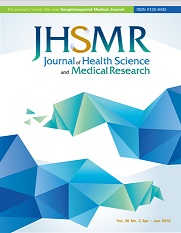Determinants of Hospital Costs for Management of Chronic-Disease Patients in Southern Thailand
DOI:
https://doi.org/10.31584/jhsmr.2021787Keywords:
chronic disease, diagnosis-related groups, hospital costs, length of hospital stay, number of proceduresAbstract
Objective: Diagnosis-related groups (DRGs) are the main mechanism for assessing payments for medical treatment. This study aimed to analyze the determinants of costs for chronic-disease patient visits in a major public hospital.
Material and Methods: Hospital cost data available from the hospital database relating to claims made to the Thailand Health Security Office were obtained from a major tertiary hospital for all such patients admitted and discharged in 2016. Linear regression models were created to predict the cost based on several determinants including age and gender, primary diagnosis, number of diagnoses, length of stay, number of procedures, and discharge status.
Results: Only length of stay in hospital and number of procedures were significant predictors of the total hospital costs.
Conclusion: It thus appears that just a combination of these two factors might be a better measure of the true hospital visit costs for patients with chronic disease than DRGs.
References
Chilingerian J. Origins of DRGs in the United States: a technical, political and cultural story. In: Kimberly J, de Pouvourville G, D’Aunno T, editors. The globalization of managerial innovation in health care. Cambridge: Cambridge University Press; 2008.
Hughes JS, Lichtenstein J, Fetter RB. Procedure codes: potential modifiers of diagnosis-related groups. Health Care Financ Rev 1990;12:39–46.
Scheller-Kreinsen D, Geissler A, Busse R. The ABC of DRGs. Euro Observer 2009;11:1-5.
Schreyögg J, Stargardt T, Tiemann O, Busse R. Methods to determine reimbursement rates for diagnosis related groups (DRG): a comparison of nine European countries. Health Care Manag Sci 2006;9:215-23.
Mathauer I, Wittenbecher F. Hospital payment systems based on diagnosis-related groups: experiences in low- and middleincome countries. Bull World Health Organ 2013;91:746–56A.
Allen C. Health education: a quick reference the go-to book for teachers. 2nd ed. Racine: Lulu Press; 2017.
Sakunphanit T. Universal health care coverage through pluralistic approaches: experience from Thailand. Bangkok: National Health Security Office; 2015.
R Development Core Team. A language and environment for statistical computing version 3.1.3. Vienna: R Foundation for Statistical Computing; 2015.
Chaikledkaew U, Pongchareonsuk P, Chaiyakunapruk N, Ongphiphadhanakul B. Factors affecting health-care costs and hospitalizations among diabetic patients in Thai public hospitals. Value Health 2008;11:S69-74.
Slabaugh LS, Curtis BH, Clore G, Fu H, Schuster DP. Factors associated with increased healthcare costs in Medicare Advantage patients with type 2 diabetes enrolled in a large representative health insurance plan in the US. J Med Econs 2015;18:106-12.
Pongpirul K, Walker DG, Rahman H, Robinson C. DRG coding practice: a nationwide hospital survey in Thailand. BMC Health Serv Res 2011;11:290.
























